Preserving Structural Integrity
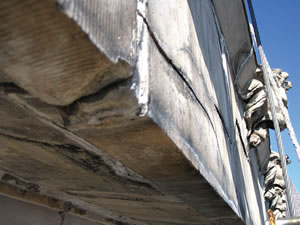
PHOTO © KEAST & HOOD
Is deferred maintenance—the practice of delaying building
repairs—quietly wreaking havoc
on your campus structures? A building’s
structural system exhibits particular sensitivity
to issues such as water infiltration,
façade deterioration, corrosion, and decay.
Whether for schedule or budget reasons,
deferring seemingly minor maintenance or
repair projects over time can cause major
concerns during building renovations.
When structural maintenance is postponed,
repairs become more extensive, expensive,
and intrusive. Addressing and correcting
outstanding issues prior to renovation will
ensure capital budgets, project schedules,
and architectural objectives can be met.
According to the Sightlines 2018 State of
Facilities in Higher Education report, which
verified data from 360 colleges and universities
across North America, annual stewardship
funds increased 50 percent from 2007
to 2017, demonstrating a long-term commitment
to building renovations. With most
campus buildings constructed between
1950-1975 and from 2000-present, capital
investment demands will soon be at an
all-time high for both groups. JLL Research
puts deferred maintenance estimates at $100
per square foot. With approximately six billion
square feet of buildings, the $600 billion
deferred maintenance price tag looms large.
Common Conditions
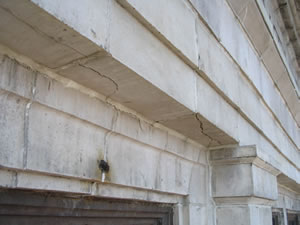
PHOTO © KEAST & HOOD
The most common deferred maintenance
issues affecting building structures include
veneer failure, masonry deterioration, steel
corrosion, and timber decay. Veneer failures
may be evidenced by masonry spalling,
when pieces break or flake off a building’s
exterior finish, and typically affect concrete,
terra cotta, and stone; corroded steel framing,
often hidden by surface materials, may
be indicated by spalling concrete encasement
or by cracks or bulges around lintels
or arches; or wood crushing, checking, and
cracking may be a sign of timber decay.
The ongoing deferment of normal building
maintenance related to these issues will
typically result in more extensive repairs
that cost more than the cumulative maintenance
sums. A deteriorated façade, for example,
may result in the continuous cleaning
of interior finishes due to leaks, could
necessitate installation of exterior safety
precautions such as netting or barriers, and
could ultimately affect the underlying building
structure, requiring costly investigative
work and supplemental shoring.
Before your renovation budget and
schedule take unexpected hits, consider
some common scenarios.
Scenario 1: Veneer Failure
If a piece of terra cotta falls on the campus
and no one is around to hear it, does it
sound an alarm?
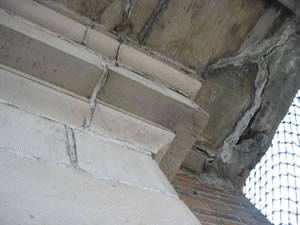
PHOTO © KEAST & HOOD
It should. Beyond the immediate safety
concern of veneer failures—that falling
pieces could cause property damage or
personal injury—these often signal more
alarming structural concerns.
On a recent project, Keast & Hood
structural engineers of Philadelphia, PA,
performed a façade and cornice assessment
after a small section of terra cotta cornice
fell to the sidewalk eight stories below.
Prior to completing the assessment, safety
netting was installed from the cornice
base up and over the parapet to prevent
future pieces from falling. The condition
assessment revealed large cracks in the
terra cotta cornice caused by corrosion of
the steel armature framing within the supporting
wall. The steel corrosion resulted
from air and moisture infiltration, which
over time caused rust jacking. Rust jacking
happens when the metal in iron and steel
products corrodes and builds up a layer of
iron oxide, or rust. The buildup of rust applies
an outward force, causing cracks and
displacements of building elements.
In this example, ongoing maintenance
could have ensured face and head joints
were in good condition, sealants and flashings
were properly applied, and the proper
shedding of water was taking place in order
to prevent the deterioration of steel and terra
cotta. A short period of deferred maintenance
may have limited the problem to
small sections that could be repaired. Instead, the condition assessment determined
an extensive problem. Not only had
rust jacking occurred in the cornice, but water
had also infiltrated the top floor window
heads, compromising the structure around
the windows and requiring additional
repairs and window replacement.
Scenario 2: Masonry Repointing
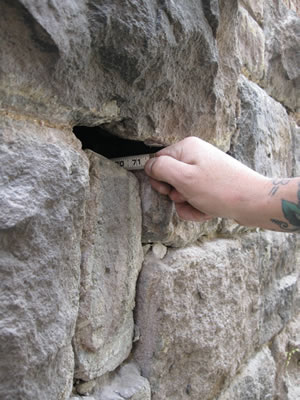
PHOTO © KEAST & HOOD
Could deferred masonry repointing—
repairing weathered or decayed exterior
mortar joints—be more than skin deep?
Mortar joints naturally deteriorate
over time. Regular maintenance to correct
voids or cracks in the mortar joints has
deeper implications than restoring the
aesthetic beauty of a façade. Repointing
also preserves the physical integrity of the
masonry and prevents future damage.
Left untreated, deteriorated mortar
joints allow water to infiltrate the façade.
Continued exposure can lead to destruction
of the mortar on the interior of the masonry
wall, creating voids within the wall
cavity. Both are difficult to detect or access.
During a renovation, repointing
the façade may be a priority. In a well-maintained
building, masons may
detect small voids. These can be filled
with additional masonry and properly
repointed. In a building with deferred
maintenance, mortar joint deterioration
could lead to larger voids or more extensive
damage. Where masons encounter large
voids, ground-penetrating radar (GPR)
or other techniques to survey the wall
may be needed to determine if there
are larger structural deficiencies. The
presence of extensive voids may require the
dismantlement and reconstruction of the
entire masonry wall section.
Scenario 3: Wood Decay
Could a crack be a sign of wood decay?
While wood checking or cracking most
often results naturally as part of the drying
process, larger cracks or those in areas
susceptible to water infiltration or insect
infestation are cause for concern. Decayed
wood members at the bottom of a wall stud
or along a sill plate may be found during
a renovation. For non-structural decayed
members, epoxy consolidation is a technique
that infuses epoxy into a void within
a wood member, rendering it sound once
again. In cases where timber decay or damage
proves more significant, reinforcement
or replacement would be necessary.
Scenario 4: Steel Corrosion
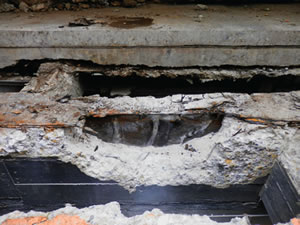
PHOTO © KEAST & HOOD
Could the steel structure be corroding
behind the walls?
Long-term corrosion not only causes
rust jacking but also diminishes the load
capacity and strength of structural steel
framing. Glimpses of corrosion may appear
as cracks above the corners of a doorway
lintel, a bulge in a steel-supported masonry
arch, or spalling of a concrete-encased steel
beam. These tell-tale signs should prompt
further investigation.
During renovation, it becomes particularly
important to ensure a building’s
structure maintains its strength and supports
the new use. Minor surface corrosion
can be removed by wire brush cleaning
and protected by applying a rust-inhibiting
coating. Extensive corrosion could require
the addition of supplemental steel members
to reinforce the corroded element. In
a worst-case scenario, the structural member
would need to be completely replaced.
Deferring maintenance of seemingly minor
cracks or bulges could impact the overall
structure, with the potential for a catastrophic
steel framing failure.
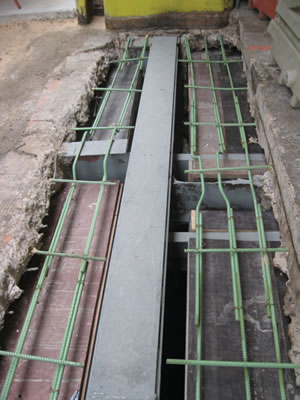
PHOTO © KEAST & HOOD
Be Proactive
Early coordination among a campus
facilities team, structural engineer, and
architect can identify issues proactively,
saving time and money and ensuring
architectural and campus objectives can be
met. JLL Research suggests regular facilities
capital assessments to give engineers
an opportunity to investigate campus
building conditions and prioritize maintenance
and repair needs.
If deferred maintenance issues may be a
concern, seek professional guidance to ensure
your building’s structural integrity may
not compromise your renovation plans.
This article originally appeared in the College Planning & Management July/August 2019 issue of Spaces4Learning.